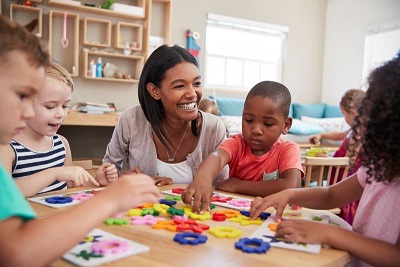Teacher Tips: Licensing Compliance in Diapering Children
Date postedAugust 15, 2019
Licensing Compliance in Diapering Children

Changing a diaper is a lot like getting a present from your grandmother - you're not sure what you've got but you're pretty sure you're not going to like it. ~ Jeff Foxworthy
As we continue our focus on Georgia’s licensing guidelines that may apply to you and your position, we dive into diapering this week. It is an important part of the routine care that you give your infants through two year olds, and your following the guidelines and practices will keep you and the child safe. Be sure that anyone in the classroom diapering a child follows your posted diapering steps each and every diaper change.
Following are some line items from the CCLC Rules and Regulations, with tips or reminders in bold italics:
Diapering Areas and Practices
(1) Ventilation. For Centers first licensed after March 1, 1991, and for Centers that are renovated after March 1, 1991, the diapering areas shall be ventilated by functioning exhaust fans and a duct system or by the required amount of window space provided by operable windows when open. While ventilation will help your classroom air out, it is likely necessary that you will need to remove stinky diaper trash immediately to prevent a lingering odor in the room.
(2) Hand Washing Sink. In Centers first licensed after March 1, 1991, and Centers that renovate existing plumbing facilities, a hand washing sink with running heated water shall be located adjacent to the diapering area. Flush sinks shall not be used for hand washing. Cleansing procedures in other facilities shall be approved by the Department. This handwashing sink should not contain any food containers, bottles, toys, or other items.
(3) Changing Diapers. Diapers shall be changed in the child's own crib or on a diaper changing surface that is used for no purposes other than changing clothes in each room where infants or any other children wearing diapers are served.
(4) If diapers are changed on a diaper changing surface, the surface shall be smooth, nonporous, and equipped with a guard or rails to prevent falls. Between each diaper change, the diaper changing surface shall be cleaned with a disinfectant and dried with a single-use disposable towel. Remember that even if you use diapering paper to cover the area, you must disinfect the area after you remove the paper.
(5) Infants and children shall not be left unattended while being diapered or having their clothes changed on the diaper changing surface. It takes a fraction of a second for a child to become severely injured if you step away from the diapering area. NEVER take your hand off of the child. Ever.
(6) Any items which might harm a child must be kept out of a child's reach. This includes diapering creams, bags, diapering supplies. Not only do you want to keep the child from potentially choking, but you also want to prevent germs from spreading to items unnecessarily.
(7) Supplies. The following items shall also be provided at the diapering area: liquid soap, individually dispensed, single-use hand towels, single-use wash cloths, and covered storage container for soiled items. Follow a system to make sure the items are always available, with extras handy for immediate replenishment.
(8) Hygiene. Staff with diaper changing responsibilities shall not be simultaneously assigned to kitchen food preparation duties.
(9) Location of Diapering Area. The area used for diapering shall not be used for food preparation. It must be clear of formulas, food, food utensils and food preparation items. Be mindful of items that might be carelessly placed in the diapering area-pacifiers, sippy cups, bottles, etc. Remind anyone to place the items elsewhere to prevent any contamination.
(10) School-age Center. Except for children with special needs who are school-age but require diapering, the above rules do not apply to School-age Centers.
Also be sure to keep the diapering and the handwashing posters displayed nearby, to meet the requirements and to remind anyone with those responsibilities. Use this care routine time to give your little one individual attention filled with language and support their developing brains need!
Following are some line items from the CCLC Rules and Regulations, with tips or reminders in bold italics:
Diapering Areas and Practices
(1) Ventilation. For Centers first licensed after March 1, 1991, and for Centers that are renovated after March 1, 1991, the diapering areas shall be ventilated by functioning exhaust fans and a duct system or by the required amount of window space provided by operable windows when open. While ventilation will help your classroom air out, it is likely necessary that you will need to remove stinky diaper trash immediately to prevent a lingering odor in the room.
(2) Hand Washing Sink. In Centers first licensed after March 1, 1991, and Centers that renovate existing plumbing facilities, a hand washing sink with running heated water shall be located adjacent to the diapering area. Flush sinks shall not be used for hand washing. Cleansing procedures in other facilities shall be approved by the Department. This handwashing sink should not contain any food containers, bottles, toys, or other items.
(3) Changing Diapers. Diapers shall be changed in the child's own crib or on a diaper changing surface that is used for no purposes other than changing clothes in each room where infants or any other children wearing diapers are served.
(4) If diapers are changed on a diaper changing surface, the surface shall be smooth, nonporous, and equipped with a guard or rails to prevent falls. Between each diaper change, the diaper changing surface shall be cleaned with a disinfectant and dried with a single-use disposable towel. Remember that even if you use diapering paper to cover the area, you must disinfect the area after you remove the paper.
(5) Infants and children shall not be left unattended while being diapered or having their clothes changed on the diaper changing surface. It takes a fraction of a second for a child to become severely injured if you step away from the diapering area. NEVER take your hand off of the child. Ever.
(6) Any items which might harm a child must be kept out of a child's reach. This includes diapering creams, bags, diapering supplies. Not only do you want to keep the child from potentially choking, but you also want to prevent germs from spreading to items unnecessarily.
(7) Supplies. The following items shall also be provided at the diapering area: liquid soap, individually dispensed, single-use hand towels, single-use wash cloths, and covered storage container for soiled items. Follow a system to make sure the items are always available, with extras handy for immediate replenishment.
(8) Hygiene. Staff with diaper changing responsibilities shall not be simultaneously assigned to kitchen food preparation duties.
(9) Location of Diapering Area. The area used for diapering shall not be used for food preparation. It must be clear of formulas, food, food utensils and food preparation items. Be mindful of items that might be carelessly placed in the diapering area-pacifiers, sippy cups, bottles, etc. Remind anyone to place the items elsewhere to prevent any contamination.
(10) School-age Center. Except for children with special needs who are school-age but require diapering, the above rules do not apply to School-age Centers.
Also be sure to keep the diapering and the handwashing posters displayed nearby, to meet the requirements and to remind anyone with those responsibilities. Use this care routine time to give your little one individual attention filled with language and support their developing brains need!
